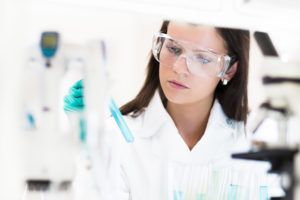Rigid protocols for embryo ID safeguard patients against IVF lab mix-ups and provide peace of mind
 We are all concerned about potential mistakes in the IVF lab. Fortunately, those mistakes are exceedingly rare. Unfortunately, as we are all human, mistakes can happen. When a mistake or mix-up happens in an IVF laboratory, it often gets tremendous exposure in the media. After all, no one ever airs a story about the millions of airline passengers who travel safely every day. However, we all hear about it when a tragic plane crash happens.
We are all concerned about potential mistakes in the IVF lab. Fortunately, those mistakes are exceedingly rare. Unfortunately, as we are all human, mistakes can happen. When a mistake or mix-up happens in an IVF laboratory, it often gets tremendous exposure in the media. After all, no one ever airs a story about the millions of airline passengers who travel safely every day. However, we all hear about it when a tragic plane crash happens.
More than 1.5 million IVF cycles in the last 10 years
Every year, there are approximately 150,000 fresh IVF cycles performed in the United States alone. If you consider only the past 10 years, that’s approximately 1.5 million IVF cycles. That figure does not even include frozen embryo transfer cycles. Yet, during this time period, there have been very few IVF lab mistakes. While none of us has access to the exact number, the exact number of errors is very small.
Regardless, even one or two IVF lab mix-ups is one too many. For this reason, we want to tell you a little about the extraordinary lengths we go to at Texas Fertility Center and our Ovation® Fertility IVF lab to ensure that we do everything possible to minimize the chance of ever making a mistake involving an embryo.
Armbands clearly identify TFC patients during retrieval and transfer
Each patient receives a personalized arm band when she arrives at the Austin Fertility Surgery Center. This band contains all of her personalized identifying information. Although your doctor knows you well, the nurses, anesthesiologist and embryologists have probably never met you. Several different people will ask to look at your arm band and confirm that you are who you say you are, both at the time of your retrieval and at the time of your embryo transfer. Even if you have the same nurse at both procedures, she will check your arm band each time. The anesthesiologist and your physician will also confirm your identity.
TFC takes a “time out” for identification of both patient and embryo
Before you receive anesthesia in the operating room, the embryologist will come into the room and also check your arm band. We will then do a “time out,” where the circulating nurse verbally states:
- Your name
- Your birthday
- Any medication allergies that you have
- The surgeon’s name
- The type of procedure
The circulating nurse, the scrub nurse, the anesthesiologist, the physician and the embryologist all confirm this information. Only after they all agree that the information is correct does the team perform the egg retrieval.
All Texas Fertility Center and Ovation staff members are trained on embryo ID safeguards to prevent IVF lab mix-ups
Although we have nine embryologists at our Ovation IVF laboratory, only one works on each patient’s case at a time. This helps prevent IVF lab mix-ups. Once the eggs are removed, they are given to a specific embryologist who places them into the appropriate dishes for culture. These dishes were made the night before your retrieval. At that time, they were labeled with your name and an accession number that is specific to you.
After your eggs have been retrieved, and you are back in the recovery area, one of the embryologists will come to see you. He or she will tell you how many eggs we retrieved. The embryologist will also confirm the identity of either your partner or the sperm donor (if you are using donor sperm) before we actually add any sperm to the dish containing your eggs. In fact, you and your partner must initial the actual laboratory form that we will use when we add the sperm to the eggs. This confirms each of your identities, as well as our instructions about the sperm to use. We then add the sperm to the eggs five hours or so after the retrieval, and then put the eggs back into the incubator overnight.
As you might imagine, our IVF laboratory is a very busy place. There are several different work stations in our IVF laboratory. However, we have a very strict rule that only one patient’s gametes can be in each area at a time. If we need to evaluate several patients’ embryos on a given day, which is common, each patient’s case must be completed and the gametes replaced into the incubator before the next patient’s embryos or gametes can be removed from the incubator.
As we have many incubators in the lab, each one has a label on the outside specifically stating the patients’ names whose gametes are in that incubator, as well as the exact location (shelf number) of those gametes within the incubator. Each patient’s identity is confirmed before and after the gametes are removed or returned to the incubator.
Visual identification of embryos, by closed-circuit video, is available to all Austin IVF patients before embryo transfer
On the day of the embryo transfer, one of the embryologists will come to your room in the preoperative area to give you a digital picture of your embryos and discuss their progress with you. Before you go back to the operating room for the transfer, your identity will again be confirmed. This will happen again in the operating room as part of the “time out” for that procedure. We will then ask you to watch the large monitor mounted on the back wall of the OR, so that you can see live closed-circuit video coming directly from the IVF laboratory.
The embryologist preparing your embryos for transfer will show you your name for confirmation. They will then show you your embryo(s) before loading them into the transfer catheter. In this manner, we will have confirmed your identity, you will see the actual embryos that we are transferring, you will confirm the actual number of embryos that we are transferring, and you will see them get loaded into the catheter.
The embryologist then brings the catheter into the OR, the doctor performs the transfer and the embryologist takes the catheter back into the lab. At that time, he or she will flush the catheter with fluid to confirm that no embryos remain. If one did not transfer, we will reload it and repeat the procedure. This is very rare and does not adversely affect your chance for pregnancy.
“Highest Quality”: Ovation Fertility receives regular inspections by CAP and the FDA
All of our policies and procedures are in a manual. We evaluate them every one to two years during our lab’s inspection by the College of American Pathologists (CAP). In addition to CAP inspection, we are subject to unannounced inspections by inspectors from the U.S. Food and Drug Administration (FDA). Our laboratory maintains the highest quality, and several of our embryologists actually serve as CAP inspectors, inspecting other laboratories around the country.
We have spent a lot of time developing and refining our protocols to minimize the likelihood that there would ever be a mistake in our laboratories. Although it may not make the news, the reality is that the odds of a mistake in a certified IVF laboratory in the United States are extremely low.














Leave a Reply